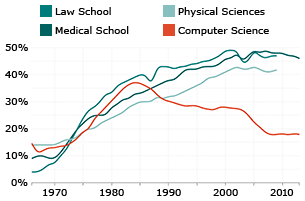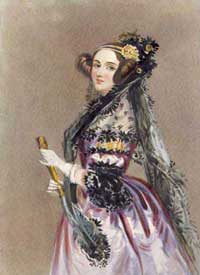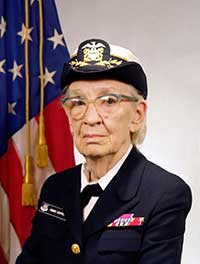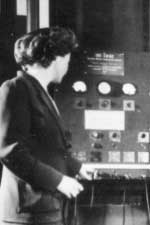Women Pioneers in Computing

NPR recently reported a troubling statistic: until the mid-
But women played key roles in the early days of computing, especially in programming. Here is an introduction to a few pioneers.
Ada, Lady Lovelace. Daughter of poet Lord Byron, Lovelace was educated in math and science — her mother wanted to make sure she didn’t become a poet.
Lovelace developed algorithms for Charles Babbage’s Analytical Engine, a nineteenth century mechanical computer. Although Babbage’s machine was never completed, it is generally accepted that Lovelace’s codes would have worked. Thus she is usually credited with being the first computer programmer.

Lovelace also was the first person to suggest that machines like the Analytical Engine could be used to analyze logical problems, not just do math. The programming language Ada is named in her honor.
Admiral Grace Hopper. Hopper earned a Ph.D. in mathematics at Yale and began her career teaching at Vassar. With the onset of World War II, she joined the Navy and was assigned to a computer lab at Harvard. There she helped program the Mark I4 electro-mechanical computer, which was used in the Manhattan Project (first atomic bomb) and to compute mathematical tables.

After the war, Hopper continued working with computers for Harvard, several private companies and the Navy. She recognized that a major obstacle to programming early computers was the need for programmers to write machine language. She thought you should be able to program in English. The idea was quickly dismissed as impossible because computers didn’t understand English.
Undeterred, Hopper created just such a language for the UNIVAC computer and was instrumental in the development of COBOL, a programming language that was once estimated as running 80% of all business programs.
Hopper continued working for the Navy into her late seventies and retired with the rank of Rear Admiral. The guided missile destroyer USS Hopper is named for her.
Hopper’s “can-do” spirit is perhaps best captured by a quotation attributed to her:
“If it’s a good idea, go ahead and do it. It’s much easier to apologize than it is to get permission.”
ENIAC Programming Team. ENIAC was the first general purpose electronic computer. Completed in 1946, it was used in development of the hydrogen bomb. Programming was done by a team of six women.

Back then Grace Hopper hadn’t yet shown how computers could be programmed in English, so these women had to “hard wire” their programs with switches and cables.
The programming team’s workspace was next to the office of John Mauchly, one of ENIAC’s principal architects. He invited the women to ask questions, and they did, using their knowledge to develop a number of the foundation concepts of programming, including that of subroutines.
After ENIAC all six women continued their careers in computing. Among other things they wrote software and designed memory and consoles for the UNIVAC computer, and worked with Grace Hopper on the development of COBOL.
Given the chart at the top of the page, It’s interesting to note the ENIAC programming team was 100% women. Today only 17% of Google’s technical employees are women.7
-----
- Steve Henn, When Women Stopped Coding, aired by NPR on October 21, 2014.
- Original Chart was created by Quoctrung Bui for NPR. This chart is reduced in size and labels were retyped for clarity. Source data are from the ABA, AMA and NSF.
- Watercolor by Alfred Edward Chalon. Image from Wikipedia.
- Portions of Mark I are on display in the science building at Harvard, see Heavyweight Computing.
- U.S. Navy photo (January 20, 1984), obtained from Wikipedia.
- U.S. Army photo, obtained from Wikipedia.
- The rate for non-technical positions is 48%. Data from Google’s web site, accessed October 27, 2014. Raw data are from Google’s EEO-1 report for 2013.
This article originally appeared in our free semi-monthly newsletter. To receive future issues, please add your name to the subscription list.

